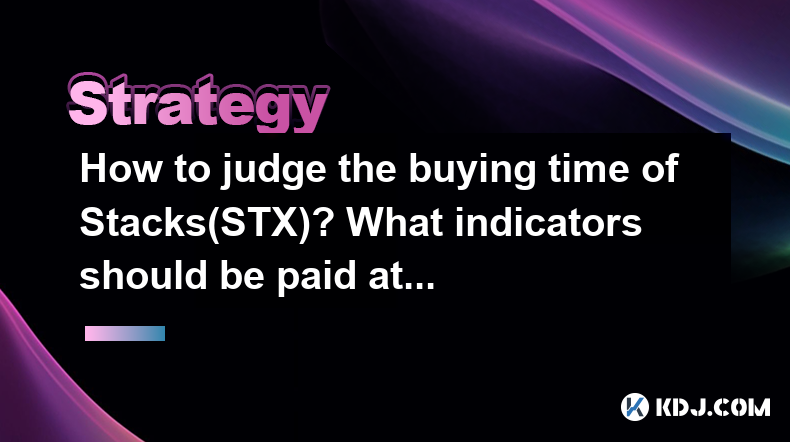-
 bitcoin
bitcoin $122025.899241 USD
-2.12% -
 ethereum
ethereum $4488.068729 USD
-4.11% -
 bnb
bnb $1315.348019 USD
8.65% -
 tether
tether $1.000457 USD
0.03% -
 xrp
xrp $2.875326 USD
-3.69% -
 solana
solana $222.043604 USD
-4.07% -
 usd-coin
usd-coin $0.999682 USD
0.00% -
 dogecoin
dogecoin $0.249887 USD
-5.62% -
 tron
tron $0.337379 USD
-2.59% -
 cardano
cardano $0.827763 USD
-5.06% -
 hyperliquid
hyperliquid $45.774531 USD
-2.43% -
 chainlink
chainlink $22.079309 USD
-5.87% -
 ethena-usde
ethena-usde $1.000156 USD
0.02% -
 sui
sui $3.482566 USD
-3.57% -
 stellar
stellar $0.386982 USD
-4.92%
How to judge the buying time of Stacks(STX)? What indicators should be paid attention to?
Use moving averages, RSI, MACD, Bollinger Bands, volume, and on-chain metrics to determine the optimal buying time for Stacks (STX).
May 03, 2025 at 09:28 pm

Investing in cryptocurrencies such as Stacks (STX) requires a strategic approach to determine the optimal buying time. Understanding the right indicators can significantly enhance your decision-making process. This article delves into the various factors and technical indicators that should be considered when looking to purchase STX.
Understanding Stacks (STX)
Before diving into the indicators, it's essential to have a basic understanding of Stacks (STX). Stacks is a layer-1 blockchain that enables smart contracts and decentralized applications (dApps) on Bitcoin. It aims to bring programmability to Bitcoin, allowing developers to build on top of the world's most secure blockchain. Knowing the fundamentals of STX can help you better interpret market movements and make informed decisions.
Market Sentiment and News
Market sentiment and news play a crucial role in determining the buying time for STX. Positive news, such as partnerships, technological advancements, or regulatory approvals, can drive the price up. Conversely, negative news can lead to a price drop. To stay updated:
- Follow reputable cryptocurrency news sources like CoinDesk, CoinTelegraph, and CryptoSlate.
- Join STX-specific communities on platforms like Reddit, Twitter, and Telegram to gauge community sentiment.
- Monitor announcements from the Stacks team on their official channels.
Technical Analysis Indicators
Technical analysis involves studying historical price data to predict future price movements. Here are some key indicators to consider when analyzing STX:
Moving Averages
Moving averages help smooth out price data to identify trends over a specific period. The most commonly used moving averages are the Simple Moving Average (SMA) and the Exponential Moving Average (EMA). For STX:
- Use the 50-day and 200-day SMAs to identify long-term trends. A bullish signal occurs when the 50-day SMA crosses above the 200-day SMA (known as a 'Golden Cross').
- Use the 10-day and 20-day EMAs for short-term trends. A bullish signal is generated when the 10-day EMA crosses above the 20-day EMA.
Relative Strength Index (RSI)
The RSI is a momentum oscillator that measures the speed and change of price movements. It ranges from 0 to 100 and is typically used to identify overbought or oversold conditions. For STX:
- An RSI above 70 indicates that STX may be overbought, suggesting a potential price correction.
- An RSI below 30 indicates that STX may be oversold, suggesting a potential price rebound.
MACD (Moving Average Convergence Divergence)
The MACD is a trend-following momentum indicator that shows the relationship between two moving averages of a security’s price. It consists of the MACD line, the signal line, and the histogram. For STX:
- A bullish signal is generated when the MACD line crosses above the signal line.
- A bearish signal is generated when the MACD line crosses below the signal line.
- The histogram can help identify the strength of the trend. A growing histogram indicates increasing momentum, while a shrinking histogram indicates decreasing momentum.
Bollinger Bands
Bollinger Bands consist of a middle band being an N-period simple moving average, an upper band at K times an N-period standard deviation above the middle band, and a lower band at K times an N-period standard deviation below the middle band. For STX:
- When the price touches the upper Bollinger Band, it may indicate that STX is overbought.
- When the price touches the lower Bollinger Band, it may indicate that STX is oversold.
- A squeeze in the Bollinger Bands can signal a potential breakout. A breakout above the upper band can be a bullish signal, while a breakout below the lower band can be a bearish signal.
Volume Analysis
Volume is a critical indicator that can confirm trends and signal potential reversals. For STX:
- An increase in volume during an uptrend can confirm the strength of the trend.
- A decrease in volume during an uptrend may indicate weakening momentum.
- A spike in volume during a downtrend can signal a potential reversal.
To analyze volume:
- Use volume indicators like the On-Balance Volume (OBV) and the Volume Weighted Average Price (VWAP).
- The OBV adds volume on up days and subtracts volume on down days. An increasing OBV can confirm an uptrend, while a decreasing OBV can confirm a downtrend.
- The VWAP is the average price of STX weighted by volume. It can help identify whether the current price is above or below the average price, providing insights into potential buying or selling opportunities.
On-Chain Metrics
On-chain metrics provide insights into the behavior of STX holders and can help identify buying opportunities. Some key on-chain metrics to consider include:
Active Addresses
The number of active addresses can indicate the level of interest and activity in the STX network. An increase in active addresses can signal growing adoption and potential price appreciation.
Transaction Volume
Transaction volume measures the total amount of STX being transferred on the network. High transaction volume can indicate strong network activity and potential price movements.
Network Growth
Network growth measures the rate at which new addresses are being created. Rapid network growth can signal increasing interest and potential future price appreciation.
To access on-chain metrics:
- Use platforms like Glassnode, CryptoQuant, or Nansen to track and analyze STX on-chain data.
Combining Indicators for Optimal Buying Time
Combining multiple indicators can provide a more comprehensive view of the market and help identify the optimal buying time for STX. Here’s a step-by-step approach:
- Monitor market sentiment and news to stay informed about potential catalysts.
- Use moving averages to identify long-term and short-term trends.
- Analyze the RSI to determine if STX is overbought or oversold.
- Check the MACD for trend-following signals and momentum.
- Observe Bollinger Bands for potential breakouts and overbought/oversold conditions.
- Analyze volume to confirm trends and identify potential reversals.
- Track on-chain metrics to gauge network activity and interest.
By integrating these indicators, you can make more informed decisions about when to buy STX.
Frequently Asked Questions
Q: How often should I check these indicators for STX?A: It depends on your trading strategy. For long-term investors, checking weekly or monthly might be sufficient. For short-term traders, daily or even hourly checks may be necessary to stay on top of market movements.
Q: Can I rely solely on technical indicators to buy STX?A: While technical indicators are valuable tools, they should not be used in isolation. Combining them with fundamental analysis, market sentiment, and on-chain metrics can provide a more holistic view of the market.
Q: Are there any specific tools or platforms recommended for analyzing STX?A: Yes, several platforms can be useful for analyzing STX. TradingView offers comprehensive charting and technical analysis tools. For on-chain metrics, platforms like Glassnode and CryptoQuant are highly recommended.
Q: How can I mitigate risks when buying STX based on these indicators?A: To mitigate risks, consider setting stop-loss orders to limit potential losses. Additionally, diversify your portfolio to spread risk across different assets. Always conduct thorough research and consider consulting with a financial advisor before making investment decisions.
Disclaimer:info@kdj.com
The information provided is not trading advice. kdj.com does not assume any responsibility for any investments made based on the information provided in this article. Cryptocurrencies are highly volatile and it is highly recommended that you invest with caution after thorough research!
If you believe that the content used on this website infringes your copyright, please contact us immediately (info@kdj.com) and we will delete it promptly.
- BlockDAG, DOGE, HYPE Sponsorship: Crypto Trends Shaping 2025
- 2025-10-01 00:25:13
- Deutsche Börse and Circle: A StableCoin Adoption Powerhouse in Europe
- 2025-10-01 00:25:13
- BlockDAG's Presale Buzz: Is It the Crypto to Watch in October 2025?
- 2025-10-01 00:30:13
- Bitcoin, Crypto, and IQ: When Genius Meets Digital Gold?
- 2025-10-01 00:30:13
- Stablecoins, American Innovation, and Wallet Tokens: The Next Frontier
- 2025-10-01 00:35:12
- NBU, Coins, and Crypto in Ukraine: A New Yorker's Take
- 2025-10-01 00:45:14
Related knowledge

Practical parameter settings for a Bitcoin multi-timeframe moving average system
Sep 18,2025 at 10:54pm
Optimizing Timeframe Combinations for Bitcoin Trading1. Selecting appropriate timeframes is crucial when building a multi-timeframe moving average sys...

How can I filter out false breakouts in Dogecoin high-frequency trading?
Sep 22,2025 at 01:00am
Understanding False Breakouts in Dogecoin Trading1. A false breakout occurs when Dogecoin's price appears to move beyond a defined support or resistan...

Techniques for identifying tops and bottoms in the Bitcoin on-chain NVT model
Sep 20,2025 at 07:54pm
Understanding the NVT Model in Bitcoin Analysis1. The Network Value to Transactions (NVT) ratio is often described as the 'P/E ratio' of the cryptocur...

What does the surge in open interest in Bitcoincoin futures mean?
Sep 20,2025 at 11:18pm
Understanding the Surge in Dogecoin Futures Open Interest1. A surge in open interest within Dogecoin futures indicates a growing number of active cont...

How can I use the Ethereum USDT premium to gauge market sentiment?
Sep 18,2025 at 11:55pm
Understanding the Ethereum USDT Premium1. The Ethereum USDT premium refers to the price difference between USDT (Tether) traded on Ethereum-based plat...

What should I do if Ethereum staking yields decline?
Sep 20,2025 at 06:18am
Understanding the Causes Behind Declining Ethereum Staking Yields1. The Ethereum network transitioned to a proof-of-stake consensus mechanism with the...

Practical parameter settings for a Bitcoin multi-timeframe moving average system
Sep 18,2025 at 10:54pm
Optimizing Timeframe Combinations for Bitcoin Trading1. Selecting appropriate timeframes is crucial when building a multi-timeframe moving average sys...

How can I filter out false breakouts in Dogecoin high-frequency trading?
Sep 22,2025 at 01:00am
Understanding False Breakouts in Dogecoin Trading1. A false breakout occurs when Dogecoin's price appears to move beyond a defined support or resistan...

Techniques for identifying tops and bottoms in the Bitcoin on-chain NVT model
Sep 20,2025 at 07:54pm
Understanding the NVT Model in Bitcoin Analysis1. The Network Value to Transactions (NVT) ratio is often described as the 'P/E ratio' of the cryptocur...

What does the surge in open interest in Bitcoincoin futures mean?
Sep 20,2025 at 11:18pm
Understanding the Surge in Dogecoin Futures Open Interest1. A surge in open interest within Dogecoin futures indicates a growing number of active cont...

How can I use the Ethereum USDT premium to gauge market sentiment?
Sep 18,2025 at 11:55pm
Understanding the Ethereum USDT Premium1. The Ethereum USDT premium refers to the price difference between USDT (Tether) traded on Ethereum-based plat...

What should I do if Ethereum staking yields decline?
Sep 20,2025 at 06:18am
Understanding the Causes Behind Declining Ethereum Staking Yields1. The Ethereum network transitioned to a proof-of-stake consensus mechanism with the...
See all articles










































































